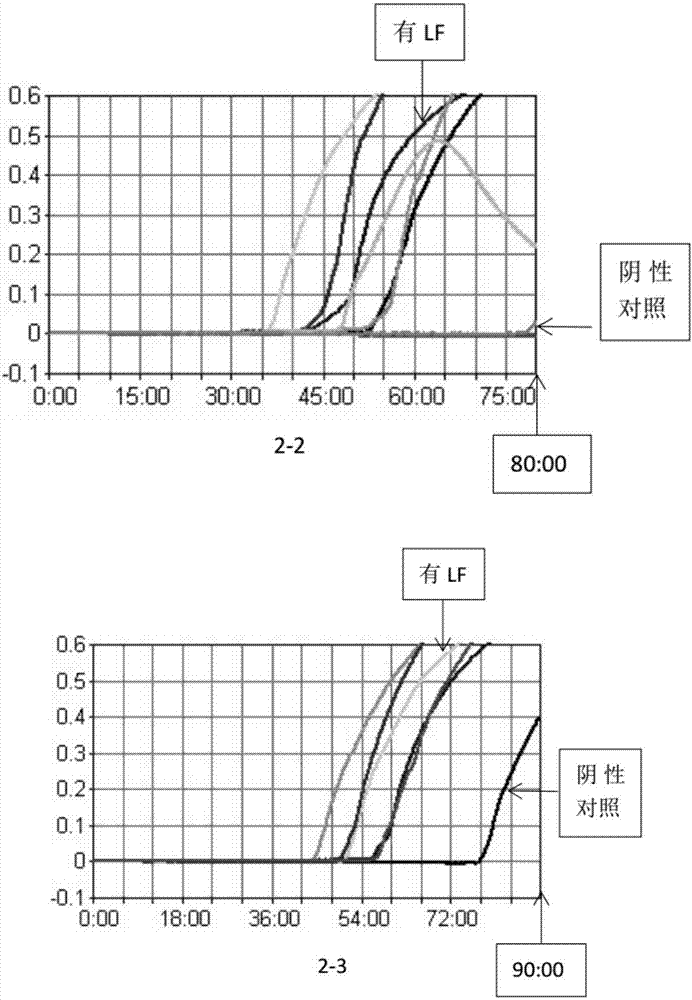Schistosoma japonicus detection method and kit and primer thereof
A detection method and technology for schistosomiasis, applied in the field of detection of parasitic disease transmission vectors, can solve the problems of inability to manufacture, long time, unsuitable loose stools, etc., and achieve the effects of an effective diagnostic approach, strong specificity and high sensitivity
- Summary
- Abstract
- Description
- Claims
- Application Information
AI Technical Summary
Problems solved by technology
Method used
Image
Examples
Embodiment 1
[0049] Extraction method of Schistosoma japonicum DNA
[0050] 1. Preparation of feces samples: Take a small amount of freshly collected feces, about 0.5 grams, put it in a 1.5 ml centrifuge tube, add 1 ml of normal saline, shake fully on the shaker, centrifuge at 14000 g for 30 seconds, discard the supernatant; store in alcohol or feces in other solutions, repeat washing 3 times, and discard the supernatant.
[0051] 2. Lysis: Add 200 microliters of lysate solution (4M urea, 200mM Tris, 20 mM NaCl, 200mM EDTA, pH 7.4) and 40 microliters of proteinase K (1mg / mL) to the precipitate, mix quickly, and incubate at 55 degrees for 0.5 -1 hour until the liquid is clear. Blow back and forth 3 times with a 1ml syringe (needle removed).
[0052] 3. Nucleic acid precipitation: add 200 microliters of binding solution (6M guanidine hydrochloride, 10M urea, 10mM Tris-HCL, 20% TritonX-100 (v / v), pH 4.4), mix immediately, and incubate at 70 degrees for 10 minutes. Add 100 µl of isopropanol...
Embodiment 2
[0059] Loop-mediated isothermal DNA amplification: Take three 0.2mL PCR thin-walled tubes and mark them as positive control tubes, detection tubes, and negative control tubes;
[0060] Add the following ingredients to each tube in turn:
[0061] Reaction mixture: 15mM Tris–HCl (pH8.6), 1.6mM dNTPs, 8mM KCl, 25mM Calcein, 0.5mM MnCl 2 , 12mM (NH 4 ) 2 SO 4 , 10mM MgSO 4 , 1.0M Betaine (Sigma–Aldrich) and Tween 20 at 0.13% by volume;
[0062] 16U of Bst DNA polymerase (New England Biolabs);
[0063] Mixed primers: 0.2 μM F3 and 0.2 μM B3, 1.4 μM FIP, 1.4 μM BIP and 1.0 μM LF; the nucleotide sequences of F3, B3, FIP, BIP and LF are shown in SEQ ID NO: 1-5 .
[0064] Add 5 μL of the DNA prepared in Example 1 to the detection tube; add 5 μL of deionized water negative control to the negative control tube; add the positive control of standard schistosome DNA to the positive control tube.
[0065] After a brief centrifugation, place it in a constant temperature water bath at ...
Embodiment 3
[0067] Loop-mediated isothermal DNA amplification: Take three 0.2mL PCR thin-walled tubes and mark them as positive control tubes, detection tubes, and negative control tubes;
[0068] Add the following ingredients to each tube:
[0069] Reaction mixture: 25mM Tris–HCl (pH9.0), 1.2mM dNTPs, 8mM KCl, 100μM hydroxynaphthol blue, 8mM (NH 4 ) 2 SO 4 , 6mM MgSO 4 , 0.6M betaine (Sigma–Aldrich) and Tween20 with a volume percentage of 0.07%;
[0070] 16U of Bst DNA polymerase (New England Biolabs);
[0071] Mixed primers: 0.2 μM F3 and 0.2 μM B3, 1.8 μM FIP, 1.8 μM BIP and 0.6 μM LF; the nucleotide sequences of F3, B3, FIP, BIP and LF are shown in SEQ ID NO: 1-5 .
[0072] Add 5 μL of the DNA prepared in Example 1 to the detection tube; add 5 μL of deionized water negative control to the negative control tube; add the positive control of standard schistosome DNA to the positive control tube.
[0073] After a brief centrifugation, place it in a constant temperature water bath a...
PUM
 Login to View More
Login to View More Abstract
Description
Claims
Application Information
 Login to View More
Login to View More - R&D
- Intellectual Property
- Life Sciences
- Materials
- Tech Scout
- Unparalleled Data Quality
- Higher Quality Content
- 60% Fewer Hallucinations
Browse by: Latest US Patents, China's latest patents, Technical Efficacy Thesaurus, Application Domain, Technology Topic, Popular Technical Reports.
© 2025 PatSnap. All rights reserved.Legal|Privacy policy|Modern Slavery Act Transparency Statement|Sitemap|About US| Contact US: help@patsnap.com



